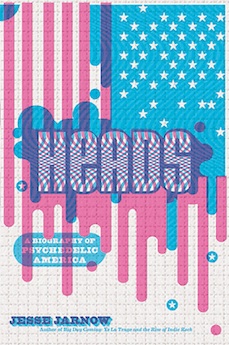By Louis J. Kern
Heads provides a kaleidoscopic excursion through the psychedelic counter-cultural community from 1964 to 2013. Less a socio-cultural history than a series of brief biographical sketches, it focuses on the centrality of the Grateful Dead to the emergence, proliferation, and persistence of an empathogenic and entheogenic drug culture grounded in ecstatic experience. As Jerry Garcia put it, “we need magic and bliss, and power and myth, and celebration and religion in our lives, and music is a good way to encapsulate a lot of it.”
But Heads also needed an underground economy. The Dead, Jarnow argues, facilitated drug exchange at concert sites, and their bootleg tapes, reduplicated and traded among Heads and fans, embodied the Hippie economic ideal of cost free, archetypically expressed by the San Francisco Diggers. Heads were not an inchoate group of rebels but surprisingly well-organized. As social rebels they needed to create social experience and group dynamics anew. As expressions of community communes, like the Morning Star Ranch (California, 1971) and the Farm (Tennessee, 1971), were founded. A sense of tribal identity emerged from the free concerts of the Dead and the massive alternative culture festivals like the Bread and Puppet’s Domestic Resurrection Circus (Vermont, 1974), and Burning Man (San Francisco, later Nevada, 1986). To fulfill spiritual needs, new religions like the Rainbow Family of Living Light (Colorado, 1972) emerged.
Jarnow’s work is something of a synthesis of the approaches to the counterculture and pop music expressed in Tom Wolfe’s The Electric Kool-Aid Acid Test (1967) and Greil Marcus’ Lipstick Traces: A Secret History of the Twentieth Century (1989). Like Wolfe, Jarnow essays a subjective account of individuals and events. But whereas Wolfe’s work is grounded in direct observation, Jarnow’s is based on eighty-six interviews and a body of print sources. His depictions of individuals are often minimal and lack the immediacy of Wolfe’s. Like Marcus, Jarnow seeks to understand the relationship of pop music to broader cultural trends but inverts Marcus’s model. Where Marcus saw the Sex Pistols (1975-77) and punk rock as the expression of an ongoing counter-history of blasphemy, anarchism, and rage, Jarnow depicts the Grateful Dead as generators of countercultural organization and ideology. As an historical approach, Marcus’s is the more convincing; he sees the Sex Pistols as a traditional expression of the avant garde rather than progenitors of the punk movement.
Heads is a “biography” of psychedelic culture in two respects. Jarnow provides an extended excursion with LSD, MDMA (ecstasy), DMT (ayahuasca) 2 C-B (Toonies, Nexus, Venus), and mescaline (peyote, ‘schrooms). A dizzying cast of characters appears, ranging from artists like Alex Grey, Jean-Michel Basquiat, and Keith Haring to Steve Jobs and Steve Wozniak and Edward Snowden, all associated with the Grateful Dead and psychedelics. Jarnow argues that the Dead were central to the development of the internet and early “asynchronous groupmind” and the origins of BitCoin. More esoteric are fleeting references to the Church of the Sub Genius (1979) of Bob Dobbs and Hakim Bey’s concept of the “Temporary Autonomous Zone.” The latter cold have been fruitfully used as an organizing principle for Heads since it describes a semi-nomadic society bound by love, festival, and the Net.
Finally, Heads is a single-minded focus on a predominantly white-boy phenomenon as a universal explanatory principle that ignores everything else going on in the US from the Vietnam War to the Civil Rights movement and the Women’s Liberation movement as well as the negative events within the Hippie community—Charles Manson, and Altamont. As a history of psychedelic America, Heads is too narrowly conceived.
Louis J. Kern (ΦBK, Clark University,1965) is professor emeritus of history at Hofstra University. Hofstra University is home to the Omega of New York chapter of Phi Beta Kappa.




